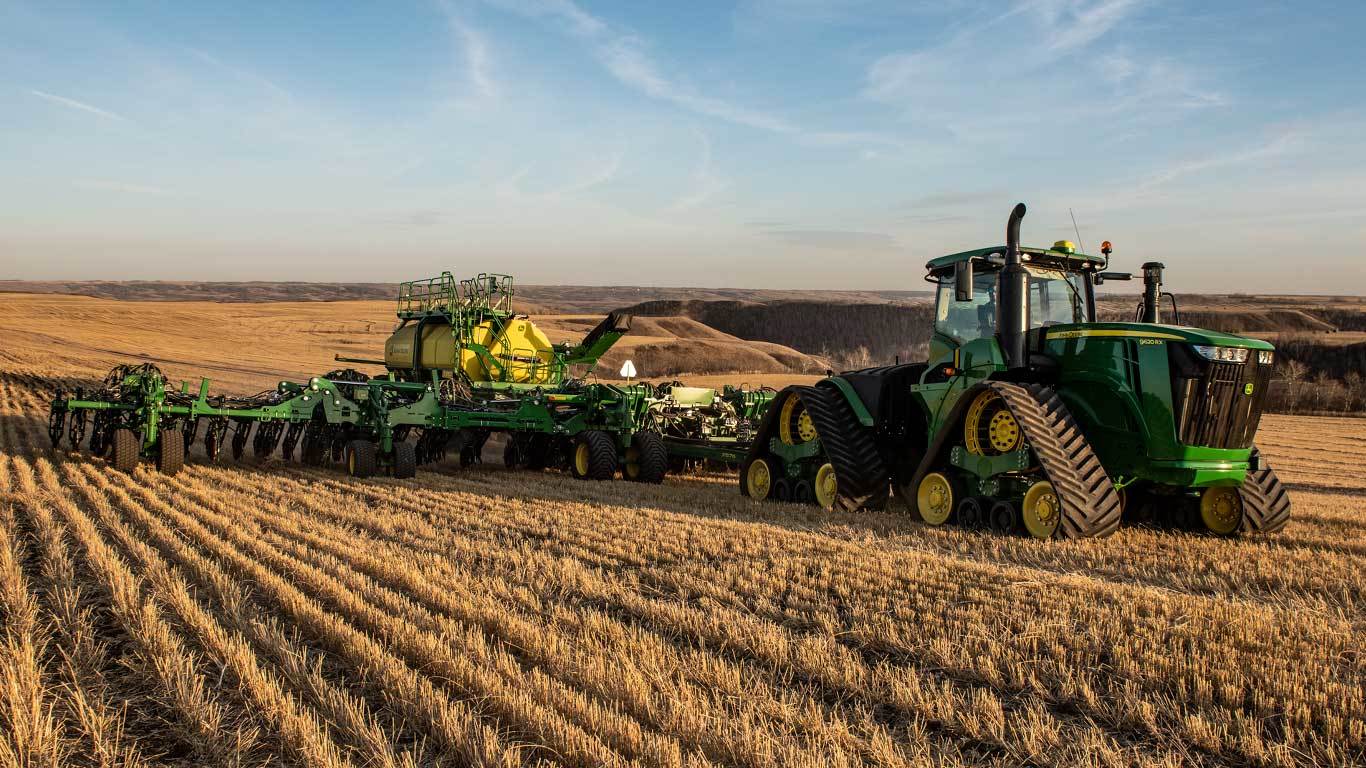
P540 Air Hoe Drill
- John Deere
- Sembradoras neumáticas
Buscar sucursal más cercana
Buscar ubicación
Características y especificaciones
- Consistent seeding rates from row to row with RelativeFlow™ blockage monitoring
- Get in the field sooner with standard high-flotation package
- 3 Section - 40 Ft. - 12 In. Spacing
- Ancho de transporte 19 ft., 22,6 ft
- Abridor Sembradora neumática
- Colocación de fertilizantes En surco
- Ancho útil 40 pies
-
Distancia entre filas
9-in. (23-cm) paired row
11,8-in. (30-cm) side band

- + Expandir todo
- - Cerrar todo
-
Opciones de distancia entre filas
Fila emparejada vs. banda lateral
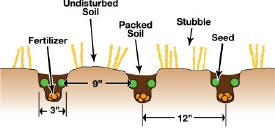 Perfil del suelo para fila emparejada
Perfil del suelo para fila emparejada

The P500 has two cast seed boots available. Depending on a grower's seed and fertilizer placement preference in different soils or different crops, the P500 can meet the user's needs. El abridor fundido fue diseñado pensando en la simplicidad. Solo se necesita un tubo. Switching from single to paired row has never been easier; simply remove the two bolts holding the cast opener in place, remove the opener, and replace with the new opener.
Fila emparejada
Con vástagos con una distancia de 30,5 cm (12 in), las filas emparejadas pueden plantarse con una distancia de 22,9 cm (9 in). Las semillas se separan en dos filas por encima y a los laterales del surco. La labranza total en esta zona es de 7,6 cm (3 in) de ancho con alrededor de un 25 por ciento de utilización del semillero (SBU).
La semilla se apoya en un estante de 2 cm (0,75 in) mientras se coloca en fertilizante en una banda de 2,5 cm (1 in) entre y debajo de las dos filas de semillas.
Con la colocación de fija emparejada, el cultivo puede tener acceso al fertilizante cuando lo necesita. La separación es la suficiente para evitar que la semilla se queme. The P500 provides a well-prepared seedbed for quick emergence and quicker canopy, which will help eliminate weeds. Si el operador quiere hacer filas más anchas, contribuye con los cultivos verdes pesados.
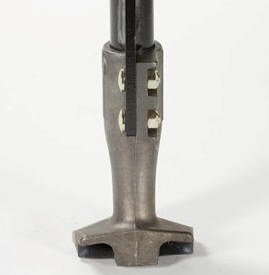 Abridor de fila emparejada - toma trasera
Abridor de fila emparejada - toma trasera
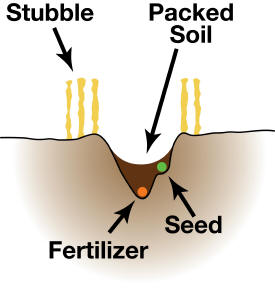 Perfil de suelo con banda lateral/fila simple
Perfil de suelo con banda lateral/fila simple

Banda lateral
If the seeding operation calls for side banding, the P500 is the needed tool. El tubo de semillas de banda lateral coloca la semilla sobre una base firme de tierra por encima y a los lados del fertilizante según sea necesario. There are 30,5-cm (12-in.) rows across the machine with positive separation between seed and fertilizer up to 11,4 cm (4,5 in.). As the seed germinates and begins to emerge, its roots will be 7,6-cm to 10,2-cm (3-in. to 4-in.) deep and into the nutrient zone.
John Deere recognizes not all seeding conditions are identical and, with the P500, offers solutions to meet seed and fertilizer placement needs.
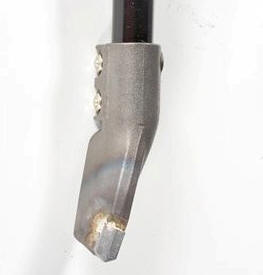 Banda lateral/fila simple
Banda lateral/fila simple
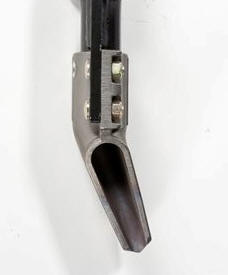 Banda lateral/fila simple - toma trasera
Banda lateral/fila simple - toma trasera
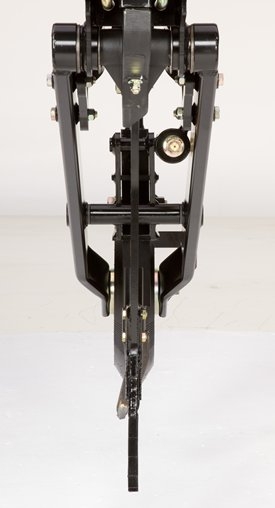 Botalón de semillas para fila simple en línea
Botalón de semillas para fila simple en línea
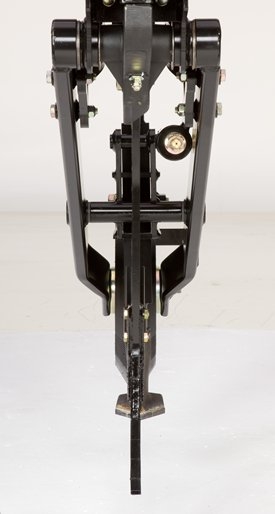 Botalón de semillas para fila emparejada en línea
Botalón de semillas para fila emparejada en línea
-
Variety of fertilizer placement
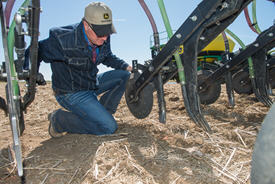
Whether using dry, liquid, or anhydrous ammonia, the John Deere P500 opener has the options that fit the application needs.





AA74478 Aqua anhydrous point
AA69276
NH3 point
AA74476
Liquid fertilizer point
AA69277
Dry fertilizer point
AA86117
Mud special point
Descripción
Austempered 10B38 boron steel point with hard-faced areas and induction fused carbide inserts to prevent wear. Carbide plates are 4-mm (0,16-in.) thick along the point edge and 6-mm (0,24-in.) thick on the tip.
Solicitud
Aqua anhydrous
Anhydrous
Liquid fertilizer
Dry fertilizer**
Fertilizante seco
Código de opción
1255
1250
1215/1220
---
1235
Tube diameter (OD)
9,5 mm (3/8 in.)
12,7 mm (1/2 in.)
6,35 mm (1/4 in.)
---
---
Pin on
X
X
X
X
X
High top
X
X
X
X
X
Suitable for dry conditions
X
X
X
X
X
Suitable for muddy conditions
X*
X*
X*
---
X
Dry fertilizer tube add-on
AA69271
AA69271
AA69271
AA69266
---
Peso
0,9 kg (2 lb)
0,97 kg (2,14 lb)
0,88 kg (1,95 lb)
0,86 kg (1,9 lb)
1,7 kg (3,78 lb)
Other information
This form of ammonia is produced by dissolving ammonia gas in water.
AA69272 hose guide is required if dry fertilizer tube is not installed.
Anhydrous ammonia is compressed into a clear, colorless liquid.
AA69272 hose guide is required if dry fertilizer tube is not installed.
AA69272 hose guide is required if dry fertilizer tube is not installed.
---
Replaces AA69279.
Wear-resistant, hard-faced welds increased by 75 percent.
Thickness increase from 4 to 8 mm (0,16 to 0,3 in.).
Extra 12,7-mm (1/2-in.) weld added close to heavy wear area.
*If not using dry fertilizer tube add-on
**Dry tube required
 Anhydrous high top tip (left) versus aqua anhydrous tip (right)
Anhydrous high top tip (left) versus aqua anhydrous tip (right)
Esta imagen muestra la diferencia entre las puntas de anhidro con parte superior elevada y de anhidro acuoso en el cuadro anterior. A la izquierda, la punta de anhidro con parte superior elevada tiene una pared del tubo más gruesa (diámetro exterior de 1,3 cm [0,5 in]) que la punta de anhidro acuoso, aunque el diámetro interno de ambas puntas es igual. También se pueden usar cuchillos de NH3 combinados con el tubo de suministro en seco incluido para quienes quieran aplicar NH3 y fertilizantes secos de forma simultánea en la misma zanja para fertilizantes.
Additional information for code 1235: the mud-proof combination of dry-fertilizer tube and tip, code 1235, is available for those applying dry fertilizers only. Se recomienda para colocar en suelos pegajosos y arcillosos pesados. Sin embargo, funciona bien en todo tipo de suelo para evitar que el barro obstruya la abertura del tubo de fertilizante. Este abridor se incluye como equipo básico.
Si se siembra solo con fertilizante seco, esta opción es muy recomendable. El fertilizante sale del tubo en su punto más bajo, para los productores que quieran colocar el fertilizante a una menor profundidad de forma más consistente.
El punto de salida del fertilizante más bajo también permite que el fertilizante llegue al fondo de la zanja cuando se desee una mayor separación del fertilizante y la semilla y para esos suelos livianos que suelen hundirse en la zanja antes de la colocación del fertilizante.
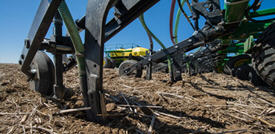 P500 fertilizer shanks engaged in the ground
P500 fertilizer shanks engaged in the ground
Tubos de fertilizante 1.) AA69266 (1250) - Fertilizante seco 
2.) AA69271 (1220/50/55) - Fertilizante seco con NH3 o líquido 
3.) AA69272 (1215) - Tubo de líquido 
-
Confidence in rates from row to row with RelativeFlow™ Blockage sensing
With RelativeFlow Blockage sensing, operators can see the flow of both seed and fertilizer from inside the tractor cab. Sensors on all secondary hoses monitor the relative product flow row to row, giving you a better view of the flow rate of both seed and fertilizer from the cart to the opener from inside your tractor cab. This technology can help you identify any problems before a potential blockage occurs.
RelativeFlow Blockage is available in all run configurations on the following models (all widths):
- H500
- H500F
- P500
- P600
- N500
- N500F
- N500C
- 730LL
RelativeFlow Blockage is compatible with hydraulic drive carts: model year 2014 and newer 1910, all 19.381,5-L (550-bu) 1910 Carts, and C650 and C850 Air Carts.
Below are the Gen 4 display screens for the blockage monitoring system. Consulte el manual del propietario para obtener detalles e información completa.
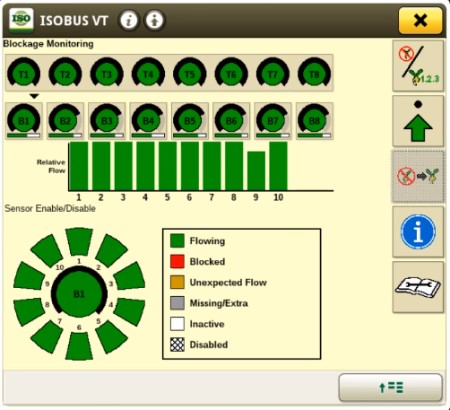 Blockage monitoring screen on Gen 4 display
Blockage monitoring screen on Gen 4 display
The RelativeFlow Blockage sensing chart shows the amount of flow through each sensor on the selected tower. La sensibilidad del sistema de obstrucción puede ajustarse si lo desea, como se muestra a continuación.
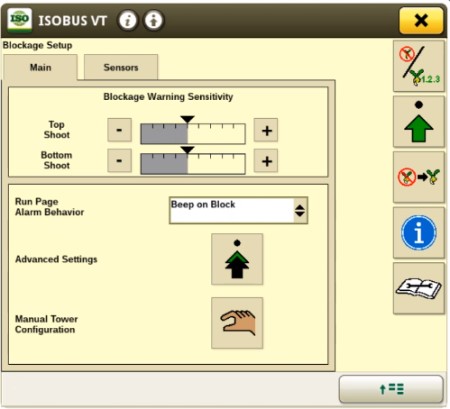 Blockage Setup screen on Gen 4 display
Blockage Setup screen on Gen 4 display
Blockage warning sensitivity allows the producer to set and change the sensitivity of the sensors to meet their preferences and varying crop/fertilizer types. Una mayor sensibilidad implica que es más probable que el sistema muestre una falsa obstrucción, mientras que con una menor sensibilidad, es más probable que el sistema pase por alto la obstrucción.
Se pueden seleccionar múltiples opciones de funcionamiento para la alarma en la página de ejecución.
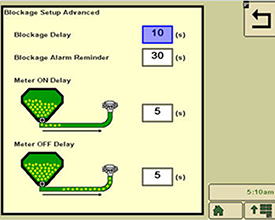 Blockage monitoring screen on Gen 4 display
Blockage monitoring screen on Gen 4 display
Below are the Gen 4 display screens for the blockage monitoring system on the N500C.
For complete details and information reference, the owner’s manual.
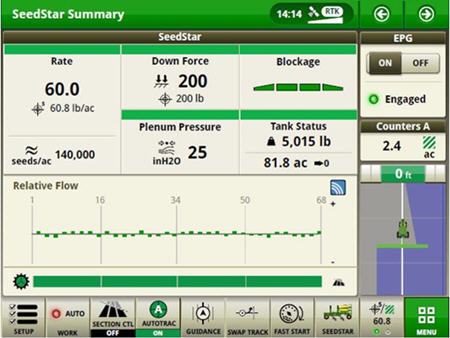 RelativeFlow Blockage configured run page
RelativeFlow Blockage configured run page
The SeedStar™ system run page displays the five major run settings. Clicking on any of the tiles will take an operator to that specific page (shown below).
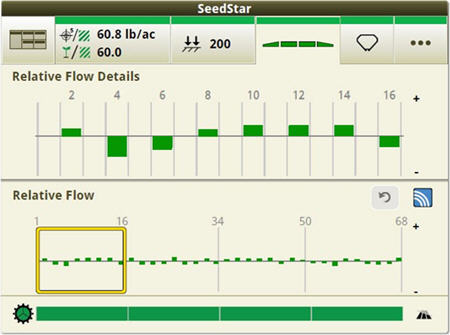 Operators can zoom into flow details by meter section when selecting blockage tiles
Operators can zoom into flow details by meter section when selecting blockage tiles
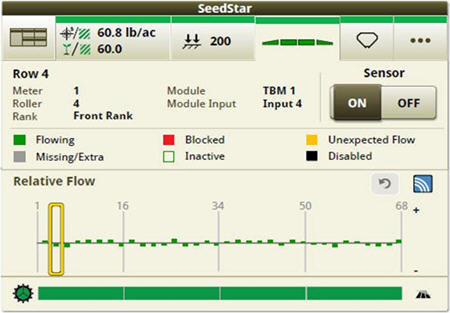 Operators can zoom into the row level to access row/sensor information and turn a sensor on/off independently
Operators can zoom into the row level to access row/sensor information and turn a sensor on/off independently
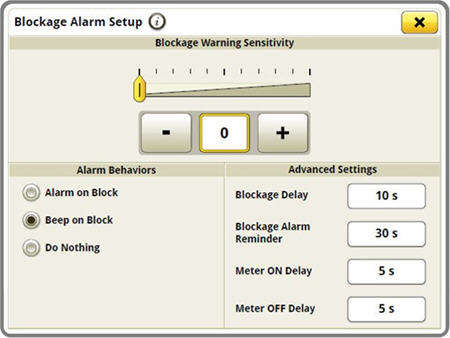 Blockage sensitivities and alarm delays are all set up on one easy-to-navigate screen
Blockage sensitivities and alarm delays are all set up on one easy-to-navigate screen
Los retrasos en la alarma de obstrucción se pueden configurar haciendo clic en el botón de configuración avanzada de la pantalla de configuración de obstrucción.
- Una demora refiere al tiempo que debe transcurrir antes de que suene la alarma por una obstrucción.
- Un recordatorio de la alarma de obstrucción establece la frecuencia con la que debe sonar la alarma cuando ocurre una obstrucción.
- La demora en el encendido del medidor refiere al tiempo desde que se enciende el medidor hasta que el sensor de obstrucción debe comenzar a monitorear.
- La demora en el apagado del medidor es el tiempo desde que se apaga el medidor hasta que el sensor de obstrucción debe comenzar a monitorear para verificar que no haya ningún caudal.
Consulte el manual del propietario para obtener más detalles.
Air tools with RelativeFlow Blockage are not compatible with 1910 air carts with ground drive.





